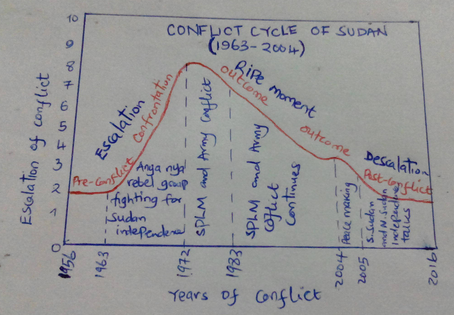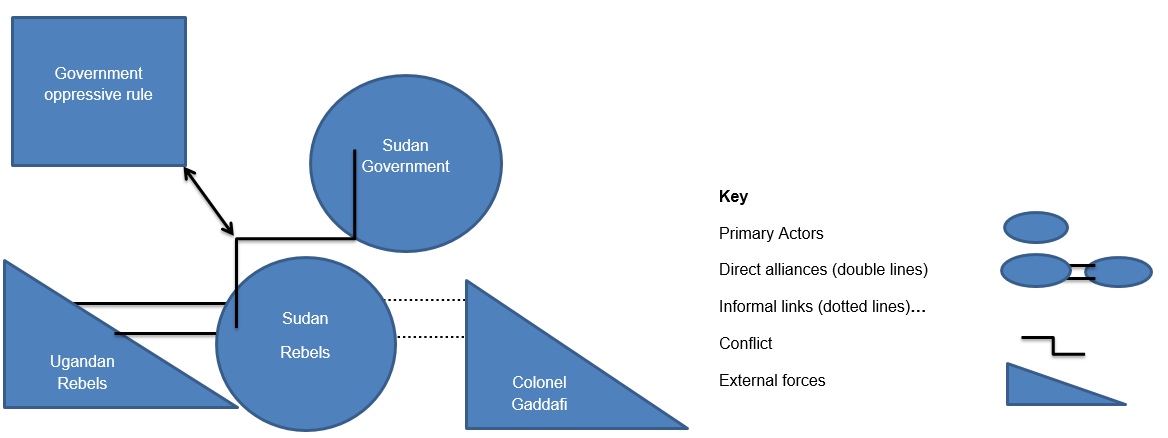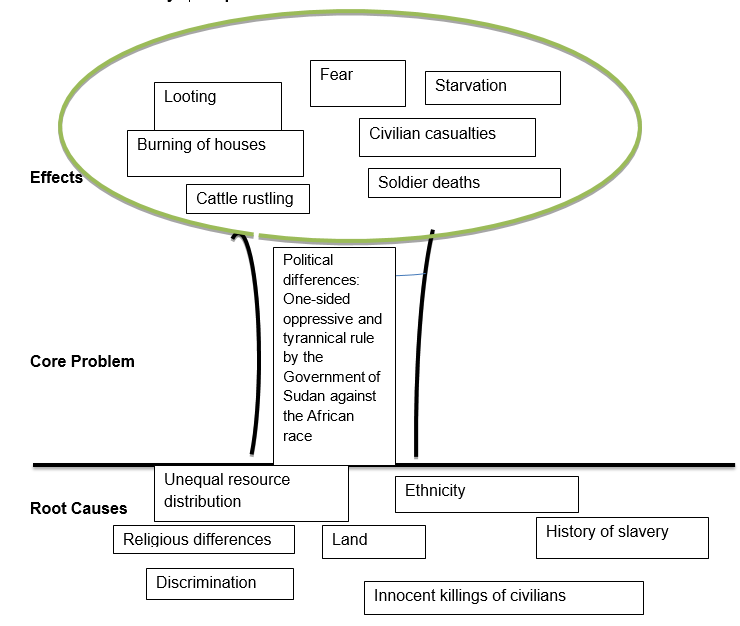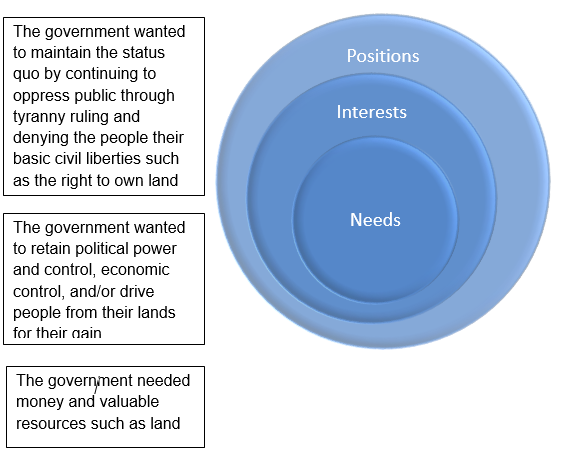Introduction
Sudan has been involved in an unending civil war since it gained its independence from the British people. The main conflicting regions are South Sudan and Darfur. Through its military and support to some ethnic-affiliated militia, the government of Sudan has been a major factor throughout the warfare through its violent interactions with the rebels. These interactions have resulted in extrajudicial killings, destruction of property, splitting of rebel groups, and an increase in tribal warfare.
The rising tension due to government crimes has resulted in the formation of rebel groups such as SPLM/A whose initial goal was to fight the government to attain political power and justice. However, through government efforts, SPLM/A split due to ethnic differences between the Dinka and Nuer tribes, which were involved in tribal wars for over 24 years before the leaders of the group opted to join forces to fight the tyrannical government.
Conflict Cycle Map illustrating the Historical Stages and Events in South Sudan Conflict

Root Causes leading to the Conflict
At this stage of the cycle, the Sudanese government’s army was involved in perpetrating one-sided violent attacks against South Sudan citizens during peaceful demonstrations. It also recruited militias to attack, kill, and burn the homes of civilians (UCDP 2016). This move resulted in an outbreak of tension among the South Sudan residents, which invoked the violent rebellions against the tyrannical ruling of Bashir’s government and his supporters (UCDP 2016).
The violence in South Sudan can be related to the theory of social conflict where the notion of aggressive actions begins at higher levels and then spreads to the lower levels of the society. For instance, the violence of South Sudan can be seen to materialize from a disagreement between the government and the rebel leaders who wanted a share of the political control. Because of antagonistic interests between the leaders and the governments, a conflict resulted and soon involved the innocent civilians who were butchered in massacres (Boxer et al. 2013).
Escalation
At the height of the violence, both the government of Sudan and the rebels were heavily involved in attacks and killings of civilians. The government recruited militias whom it sent to attack and kill civilians in their villages by burning their houses and looting their property (UCDP 2016). According to the social conflict theory, the continued commissioning of violence interculturally during warfare legitimizes and normalizes the violence, thus reflecting the continued increase in the number of casualties (Boxer et al. 2013). Therefore, during this part of the cycle, the SPLM/A split due to ethnic differences that led to ethnic-based violence between the Dinka and the Nuer tribes. The violence extended for over two decades where it resulted in the death of civilians.
Ripe Moment
The violence between the two tribes came to a deadlock where it provided an opportunity for the leaders to engage in dialogue to come up with an amicable agreement to end the violence against each other and instead unite to fight their common enemy – the Government of Sudan (UCDP 2016).
De-escalation
In 2005, the two tribes announced that they had decided to end the violence against each other. They united to fight the government of Sudan. In May 2006, the SLM/A (MM) attacked civilians of Darfur as a strategy to force the people to agree to sign the Darfur Peace Agreement that was meant to de-escalate the violence in the region (UCDP 2016).
Change of Battle Deaths and other forms of Casualties during the Conflict Cycle in South Sudan
The Escalation Stage
Government of Sudan – Civilians
During the earlier stages of the violence, the government used army men to perpetrate violent acts against the southern rebel supporters. The armed militias attacked villages, burned down houses, and randomly shot at innocent civilians of the southern tribes that were believed to be supporters of the rebel group. It is estimated that the government, through the army and militias, resulted in the death of about 1000 civilians.
JEM – Civilians
In 2003, JEB, a rebel group, was responsible for carrying out attacks against Arab civilians living in Darfur. Citing the Reizgat attack as a case in point, the rebels killed innocent women, men, and children while also being involved in stealing cattle and other valuables from the casualties (UCDP 2016). After the attack on the civilians, the rebels went ahead and massacred government troops from their areas of residence.
SLM/A – Civilians
The Sudan Liberation Movement/Army was responsible for the clashes that took place in Darfur. The movement was involved in antagonizing the government of Sudan and the Janjaweed before it split into SLM/A and SLM/A (MM) (UCDP 2016). After their split, the two tribes were involved in violent ethnic clashes that resulted in the death of 87 civilians while engaging in theft of cattle and kidnappings on Arab villages. In addition, a few aid workers were among the casualties.
SPLM/A – Civilians
This group of rebels was involved in acts of violence during the period between 1989 and 2004. The warfare was caused by a split due to ethnical differences between its two leaders, namely, John Garang of the Dinka tribe and Riek Machar of the Nuer tribe. The two divisions raided and killed civilians by burning their houses and random shootings. The attackers were also involved in the looting of property during the course of their attacks.
SSDF – Civilians
The SSDF was formed after the split in SPLM/A due to ethnical differences between the Dinka and Nuer leaders. The attackers raided Dinka villages besides killing their men, women, and even children while at the same time looting their property.
The Ripe Moment Stage
After the two sides of the rebel groups came to a deadlock in their conflicts, they decided to have peace talks that resulted in the announcement to cease the escalating violence against the Sudan government. This unification led to a reduction in the number of deaths and casualties that were caused by the conflict between the two tribes.
The De-escalation Stage
In 2005, the Dinka and Nuer tribal leaders united to fight the government, a move that resulted in a reduction of the number of deaths and casualties from the conflict. In 2011, a referendum was carried out, which led to South Sudan becoming an independent state. During this part of the cycle, the number of deaths and casualties was immensely reduced, although death reports because of border conflicts between North Sudan and South Sudan were given.
The Sudan Liberation Movement/Army (SLM/A) was involved in the killing of thousands of people as a strategy to force the people in the Darfur area to agree to the signing of the Darfur peace agreement.
Key Actors and the Main Issue of the Conflict using the Bubbles Map

Primary Actors
The Government of Sudan
The government was a major primary actor in the conflict of Darfur and South Sudan through its response to the rebel groups that were fighting against it. The government used different secondary parties to castigate its mandate such as army soldiers and pro-government militias such as the Janjaweed. These forces were involved in extrajudicial killings, burning houses, killing civilians (women, men, and children), and looting the property of their casualties. In addition, the government used the strategy of divide-and-rule where it facilitated the split of the rebel groups into smaller tribal movements that were responsible for the increased violence against each other (UCDP 2016).
The JEM (Justice and Equality Movement)
The formation of the Islamic Darfur-based JEM was driven by the agenda of gaining political power and pushing for a political change such as the implementation of the constitution in accordance with Muslim laws. The movement was involved in a number of tribal and interstate violence that resulted in the death of 69 civilians (UCDP 2016).
The SLM (Sudan Liberation Movement/Army)
The SLM was an alliance among the many tribes, both Arabs and Africans, whose main goal was to decentralize the government of Sudan. The movement was initially involved in the killing of militia and government soldiers. However, it later included civilians after the split that took place between SLM/MM and SLM/A. The group split into two groups, namely, SLM/A and SLM/A (MM), which were involved in violent interactions against each other. The violence resulted in the death of civilian tribes.
The SPLM/A
Before the split, the group that constituted the Dinka and Nuer tribes was involved in the killing of government soldiers and militias. However, due to ethnic differences, the leaders of the Nuer and Dinka tribes split. Because of the division, leaders of the two ethnic groups were responsible for leading their militia groups into violent acts such as the burning of houses, the killing of innocent civilians, and looting of material goods.
SSDF
The SSDF constituted the Nuer ethnic group that was involved in attacking and killing civilians of the Dinka tribe. However, the SSDF would later end the war against the Dinka after the leaders held peace talks with the result of unification to fight the government of Sudan.
Secondary Actors
Ugandan Rebels
Ugandan and South Sudan rebels were involved in a mutually benefiting alliance where they provided support for each other during both the Ugandan and the South Sudan wars.
Colonel Gaddafi
By promoting clashes in Chad, Gaddafi was the reason behind the displacement of Arabs who later occupied the region of Darfur where they got involved in tribal and land confrontations with the natives (UCDP 2016).
The Main Issue of the Conflict
The main issue of the conflict was the need to drive political change in the state of Sudan. The Sudanese government was accused of the tyrannical oppressive rule that was tainted by one-sided violent attacks against civilians through its involvement in random shootings of nationals while holding peaceful demonstrations, extrajudicial killings, burning of residents’ households and stealing of property of their victims. Based on the critical theory, an oppressive society by the leader reinforces the mobilization of certain societal members for the sake of the rest in an effort to have their needs, interests, and positions such as equality of their people, improvement of the living standards of the people, and a push for equal distribution of resources met. As a result, the rebel groups mobilized against the government forces with the vision of overthrowing the ruling regime from power to form a democratic and just government, thus eventually leading to warfare (Hansen 2008).
Key/Root Causes of the Conflicts
Conflict Tree Analysis Map

Political Differences
The existing political differences between the ruling regime and the rebels were the core problem that sparked much division in the state. The rebels asserted that their reason for using an armed struggle was to free the country from the oppressive rule of the one-sided government and for the formation of a decentralized government. In addition, the split between the Dinka and the Nuer tribes that led to a 24-year period of tribal warfare was caused by ethnic political differences between the two leaders of the SPLM/A rebel group.
Innocent Killing of Civilians
Government forces were involved in the killing of civilians through random shootings during peaceful demonstrations. In addition, the forces raided the villages of civilians by burning their houses, butchering them, and looting their property. This state of affairs led to increased tension, which invoked the formation of rebel groups whose mandate was to fight against the government of Sudan.
Ethnicity
Ethnic differences between the Dinkas and Nuers led to tribal wars where the soldiers/militias were involved in lootings, burning of households, and killing of civilians. According to the ethnic conflict theory, the differences between the conflicting groups determine the probability of having a conflict. Caselli and Coleman (2013) suggest that physical differences are the most influential elements in determining whether the two ethnic groups will develop a conflict, followed by differences in language and/or culture. Therefore, in the case of the Dinka-Nuer conflict, the difference in language/culture may probably have facilitated the confrontation between the two ethnic groups.
Discrimination and unequal resource distribution
Besides the crimes committed against the supporters of the rebellion, the African people were driven away from the oil-rich areas in the western part of the Nile River, a situation that invoked claims of discrimination by the government. This action by the government inspired the formation of rebel groups whose purpose was to fight for justice for the oppressed people through forming a democratic government.
Religious Differences
Religious divisions were evident between the Arabs and Muslims. Some of the rebel groups such as JEM were motivated by the existing religious differences in Darfur. The goal of the movement was to establish an Islamic governed state by applying the laws of Islam for both Muslims and non-Muslims (UCDP 2016).
Onion Map: Findings from South Sudan Conflict

Conclusion: Main Difficulty in the Resolution of the Conflict
The South Sudan conflict can be classified as a protracted conflict due to its complexity that is characterized by the involvement of both primary and secondary actors, various causes, and the highly conflicting needs, interests, and positions between the rebels and the government of Sudan. Nevertheless, the main difficulty lies in the antagonistic positions, interests, and needs between the government officials and the rebels. This situation has led to neither side willing to de-escalate the violence due to its determination to have its needs, interests, and positions met.
References
Boxer, P, Huesmann, L, Dubow, E, Landau, S, Gvirsman, S, Shikaki, K & Ginges, J 2013, ‘Exposure to Violence across the Social Ecosystem and the Development of Aggression: A Test of Ecological Theory in the Israeli-Palestinian Conflict’, Child Development, vol. 84, no. 1, pp. 163-177. Web.
Caselli, F & Coleman, W 2013, ‘On The Theory of Ethnic Conflict’, Journal of the European Economic Association, vol. 11, no. 1, pp.161-192. Web.
Hansen, T 2008, ‘Critical conflict resolution theory and practice’, Conflict Resolution Quarterly, vol. 25, no. 4, pp. 403-427. Web.
UCDP 2016, Sudan: One-sided Violence Information. Web.